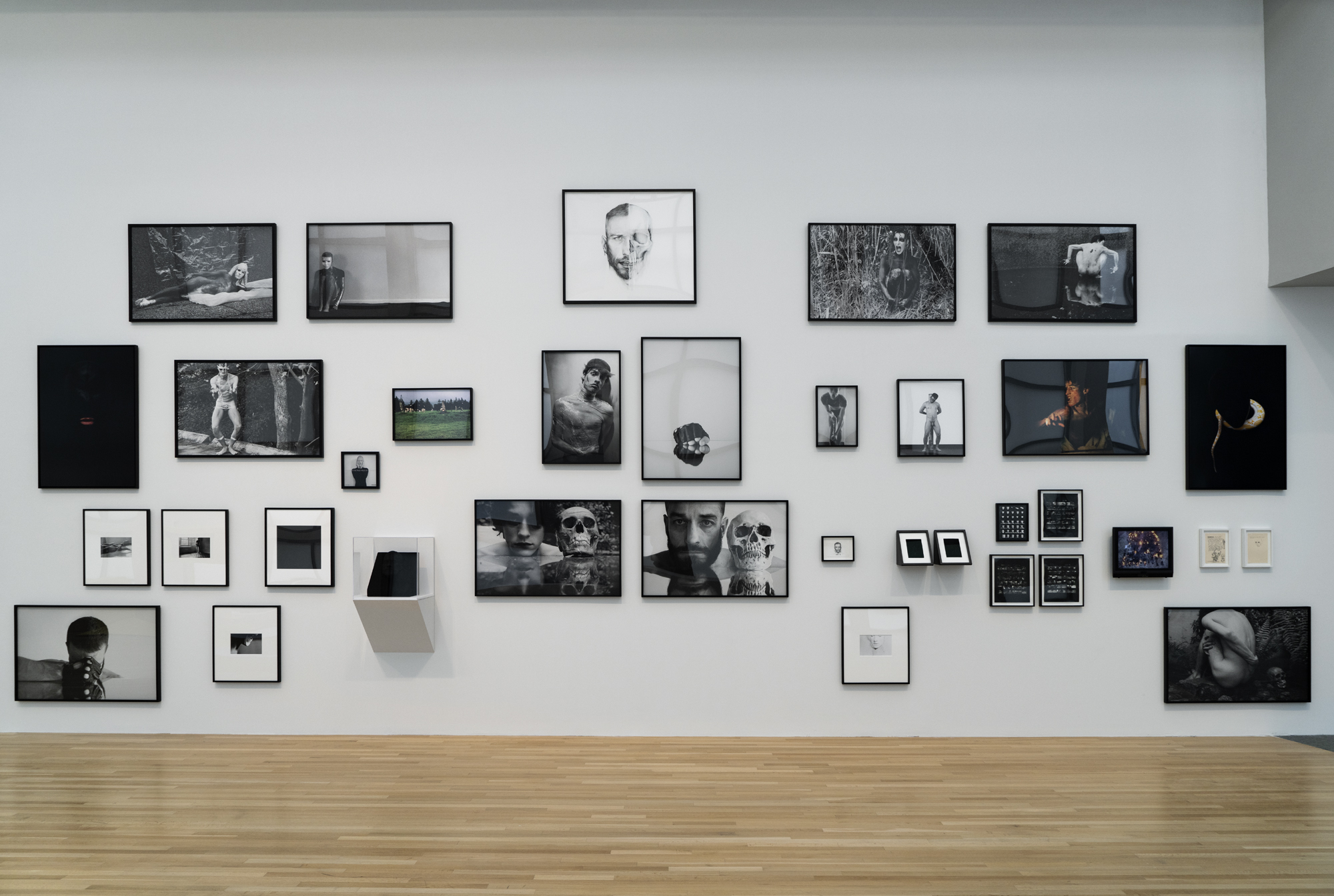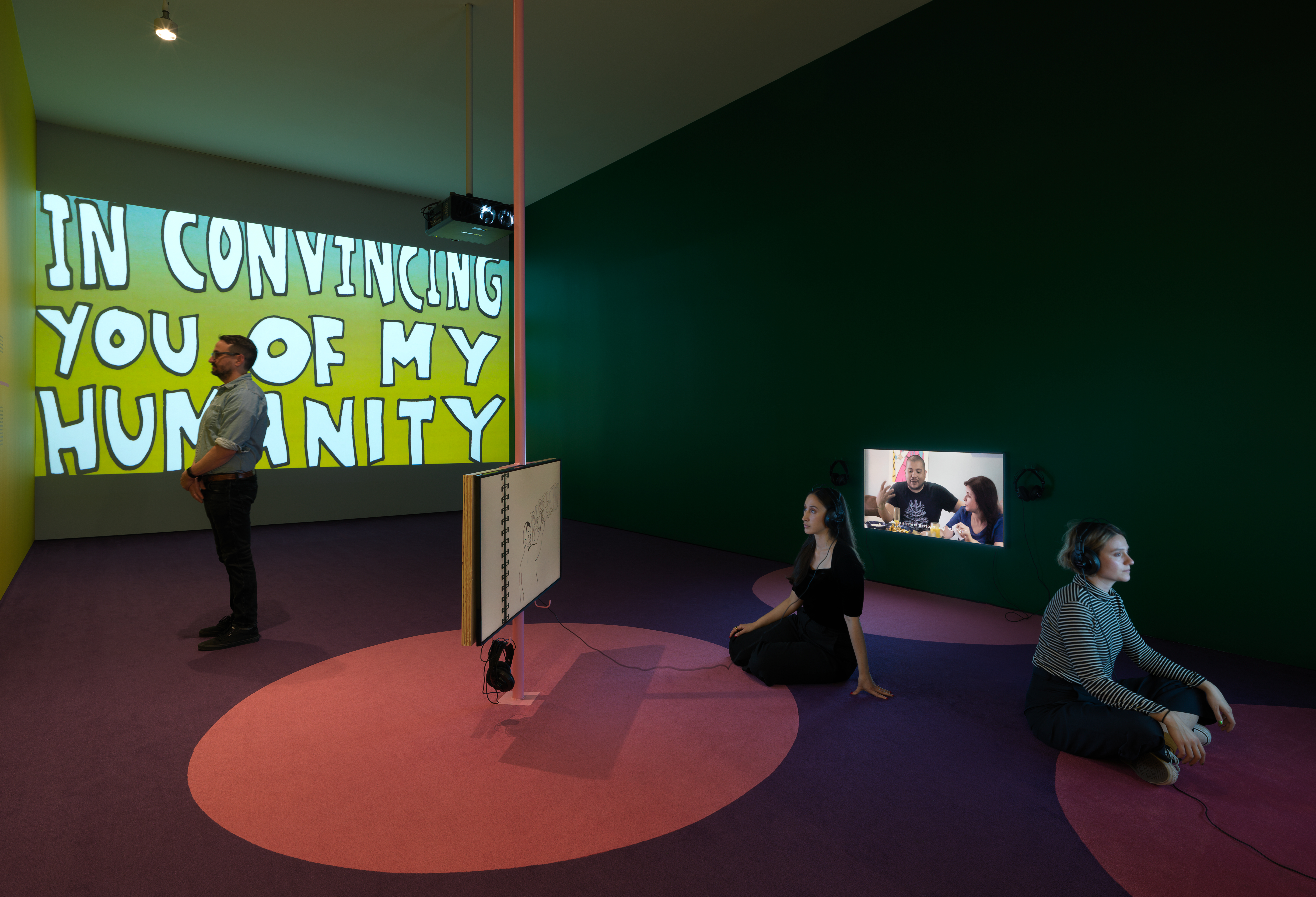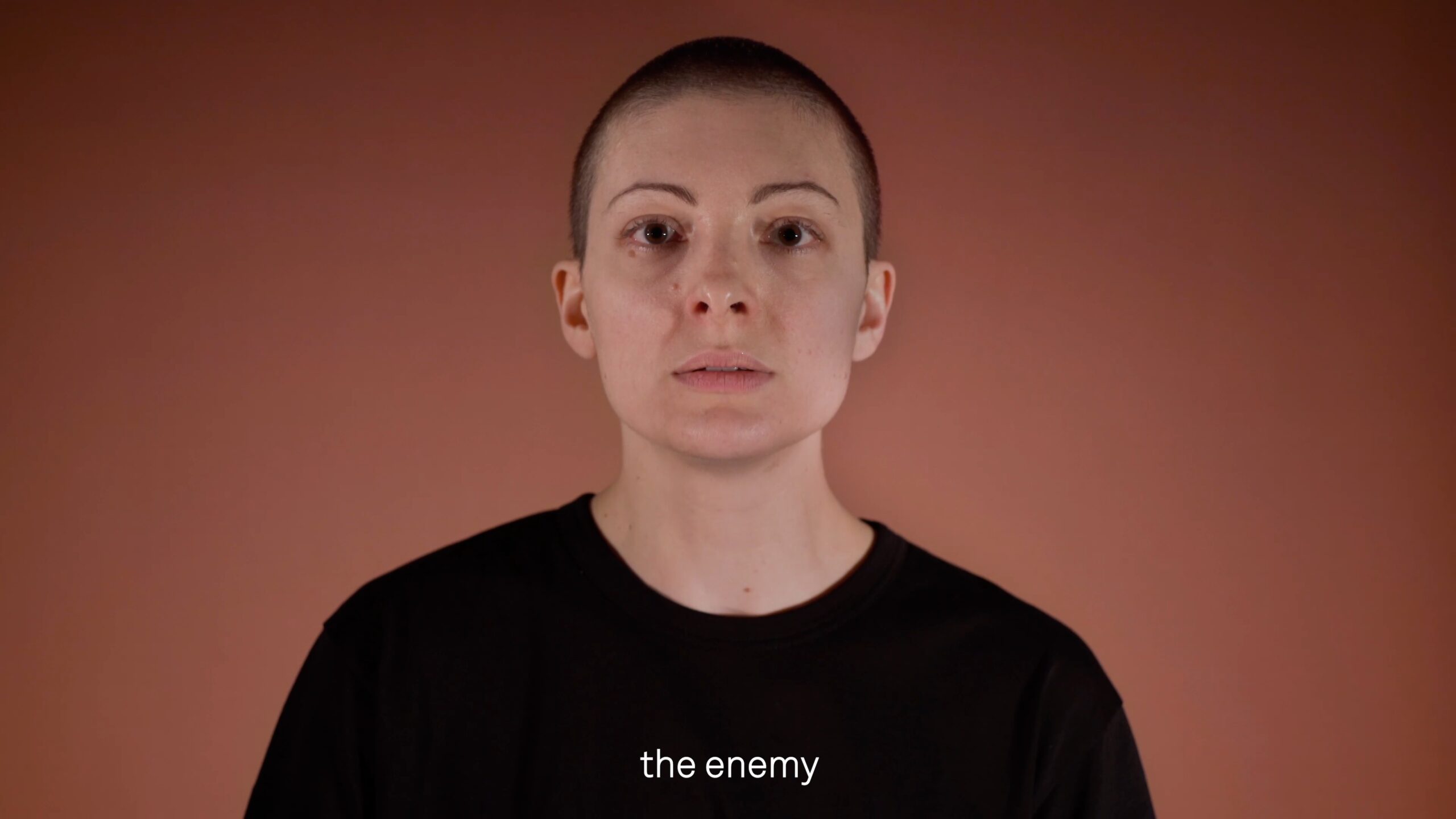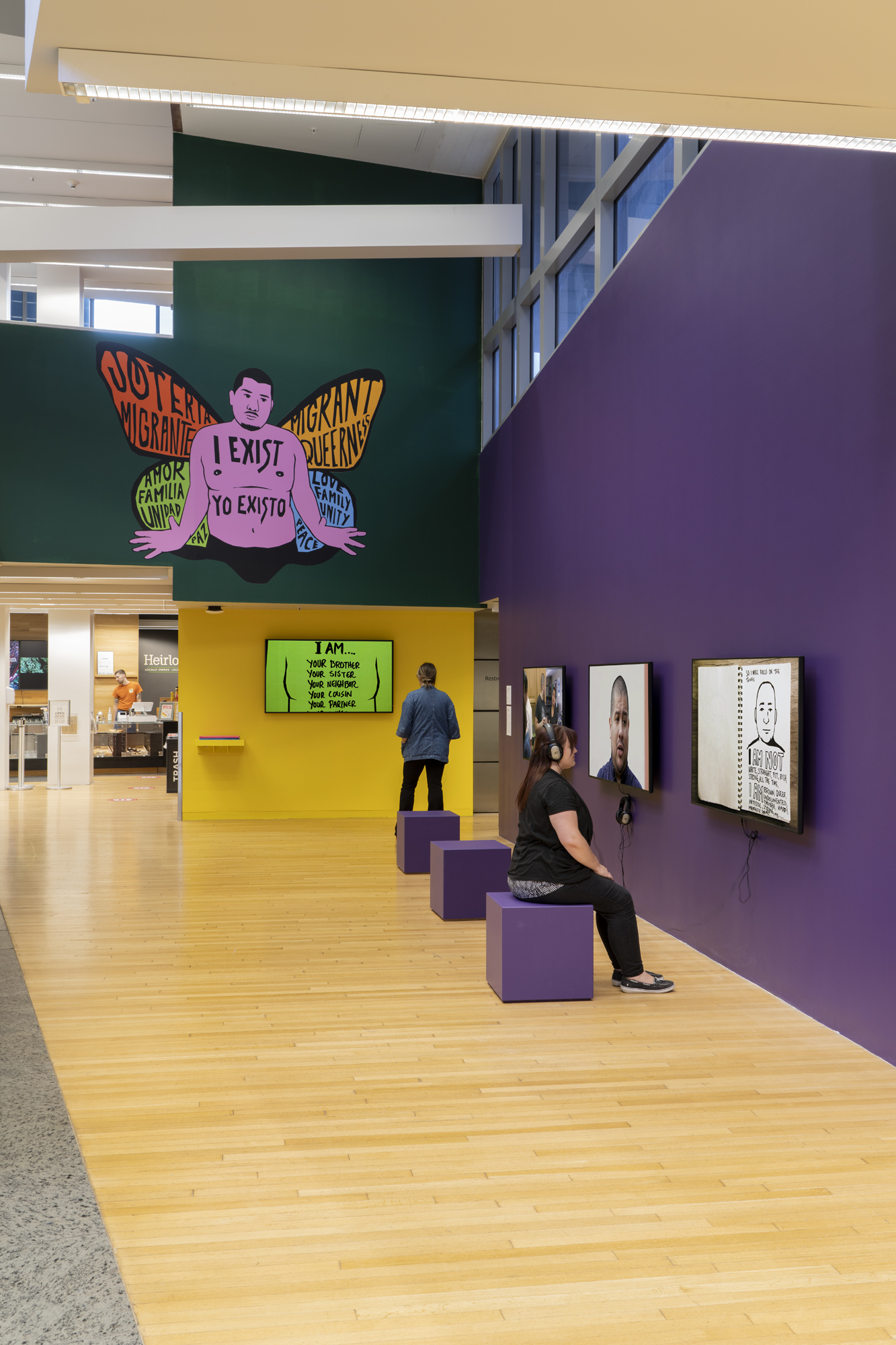It Shall Not Be Named – Carlos Motta: Your Monsters, Our Idols

Carlos Motta, Your Monsters, Our Idols, installation view, 2022 [courtesy of the artist and Wexner Center for the Arts at The Ohio State University, Columbus]
Share:
The exhibition Your Monsters, Our Idols—with video, sculpture, photography, and installation works by Carlos Motta, and curated by Lucy Zimmerman—is a teaching tool as much as it is an aesthetic experience. Therefore the Wexner Center for the Arts in Columbus is its ideal venue. Motta’s work is made sharper, and even more audacious, by the building designed by architect Peter Eisenman and completed in 1989. I was told by both curator and artist that the building’s grid served as inspiration for the exhibition’s installation by providing scenographic methods, such as the bold presentation of video in gridlike frames mimicking the building itself. Your Monsters’ curatorial aim was guided by three artworks: the video Mourning Stage (2020/2022), which runs 16 minutes, in which a performer imitates faces of various monsters; it appears alongside We the Enemy (2019), an installation of 41 miniature bronze sculptures, and across from the video also titled We the Enemy (2019). Zimmerman sought to situate Motta’s work through the lens of monster metaphors. What stood out most to me here was the artist’s razor-sharp queer sociology and his poetic filmmaking.
Often, the characters within Motta’s films are historical figures or nameless, faceless narrators. Sometimes Motta is his own narrator. Other times we do not know, or might never fully know, who or what is speaking: a human, an animal, an invented persona, an ancestor, a monster. His films embrace lushness. That is, his shots are wide, as in Deseos (Desires), commissioned by Council for a premiere at Ashkal Alwan in 2015, and shown at the Contour Biennial in 2017. His views are panoramic, as in the video-film Nefandus (2013), also in the exhibition. Viewers are ushered into a dialogue already taking place between one nameless subject and another. Whether we will learn the names of these characters is not made clear. This namelessness is one of Motta’s best strategies. Motta seeks to dismantle normalized ways of looking: how we look at Christopher Columbus, for example. Throughout the exhibition, the artist engages viewers’ discomfort by animating the image of monsters in art history.
Carlos Motta and Julio Salgado, We Got Each Other’s Back–Chapter 1: Narrative Shifter: A Portrait of Julio Salgado, 2019/2020, Four channel video installation with carpet and timeline. Video approximately 80 minutes [courtesy of the artists and SFMOMA, San Francisco]
This tension between visibility and invisibility is at the core of the exhibition. In his more recent included works, such as We Got Each Other’s Back Chapter 1: Narrative Portrait of Julio Salgado (2019), on undocumented Chicano artist Julio Salgado, or in older film installations, such as The Crossing (2017), that feature queer migrants, there is the immediate recognition of a human figure, and simultaneous misrecognition of the work’s subject. Motta aims to teach, but this learning does not come easy. The subject can be iconoclastic. Motta’s fascination with portraiture comes from the diaristic tradition of first-person narratives in canonical works of modern literature, such as ones by André Breton, Gertrude Stein, and Gustave Flaubert. These figures aimed to dismantle the sacred within language.
Yet Motta’s “portraiture” reminds us less of plot or action than it does of the poetic and ekphrastic. For example, in Nefandus, we are looking quite directly at a river and the slow progression of a canoe. The narrator (a descendant of Indigenous Colombians) speaks about the erasure of his culture and the perils of colonialism. Like most of Motta’s artworks, Nefandus is grim and beautiful. If it is a portrait, it dares to frame the subject of the film as surreal or metaphysical. Such symbolic and literary motifs in his work include rivers, landscapes, monsters, and artifacts of various kinds. Although Motta’s work is often research-driven and thus points to concrete facts within the archive, or in history, the methodology of his visual practice pursues a tension between visibility and invisibility, and is ultimately pedagogical. The viewer must do some work to fully grasp the artist’s point of view. Those viewers who are unwilling to take the necessary time will be excluded. I spent approximately one hour watching We Got Each Other’s Back, the first video encountered in the exhibition.
SPIT! (Sodomites, Perverts, Inverts Together! (Carlos Motta, John Arthur Peetz, Carlos Maria Romero)), We the Enemy (still), 2019, HD video with color and sound, 3:50 minutes [courtesy of the artists and P·P·O·W, New York]
Politics of the visible and invisible, which may signify Motta’s relation to activist groups such as ACT UP, are revealed in an interview with curator Lucy Zimmerman about Motta’s works. She says that the artist’s films could be viewed through a lens of hypervisibility and absence. That is, absence in “what is not there” and, thus, Zimmerman reminded me about the tensions of name versus namelessness evident throughout the show, as in the attempt to rename the city of Columbus. As Roland Barthes says, “That which cannot be named is a disturbance”—for example, those who perhaps have been viewed as “too horrific to be defined,” such as the “perverts,” or the “sodomites” in We the Enemy (2019).
Some queer event unfolds in many of Motta’s works, including the aforementioned We Got Each Other’s Back. However, his queer sociology and his work’s queer theory aim to challenge sexual, gender, class, and racial norms, and thus present a view of the binary order as culturally imposed rather than as natural law. I was tremendously moved by a section of the film in which Salgado identifies his artistic inspiration—Mexican modern painter Frida Kahlo. His homage tattoo across both forearms is a replica of Kahlo’s 1939 painting The Two Fridas. Rather than view the two Fridas in the painting as one gender, he inscribed “ama” on one arm and “apa” on the other to connote a gender difference.
Carlos Motta, Your Monsters, Our Idols, installation view, 2022 [courtesy of the artist and Wexner Center for the Arts at The Ohio State University, Columbus]
This artistic strategy appears in the film When I Leave This World (2022)—which is also in the Wexner exhibition but debuted at OCDChinatown. Motta wrote about the work: “If political discourse dehumanizes those [whom] the State would imprison, conquer, or kill, then the recognition and valuation of difference has long been understood as a process of humanization.” This statement reflects his collaboration with Tiamat Legion Medusa, who aimed at becoming a “human dragon through body modification.” The paradox here concerns the tension between human and reptile. Yet Motta’s queer sociology has multiple inquiries. If We Got Each Other’s Back reveals critical facts about the legal history of undocumented and queer migrants, the exhibition’s centerpiece, The Colombus Assembly (2022), a multichannel sound installation on the potential renaming of the city of Columbus, revealed the tumultuous legal debates occurring in South Minneapolis around restoring the Indigenous name of a famous lake. The implications of his critical and sociological initiatives will no doubt create a moment of listening. In all these ways, Motta has managed to read and school his audience for filth.
Serubiri Moses is a Ugandan writer, currently based in New York.


